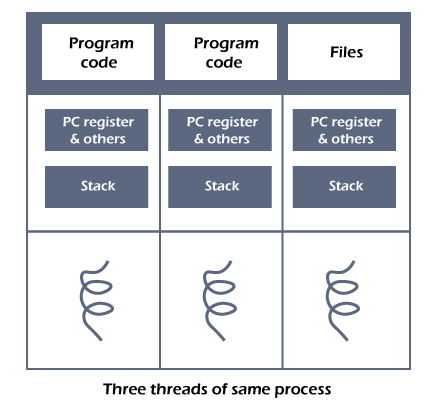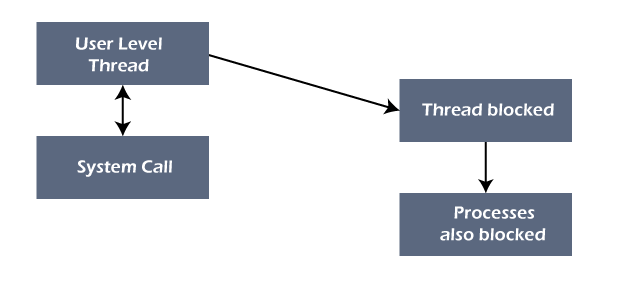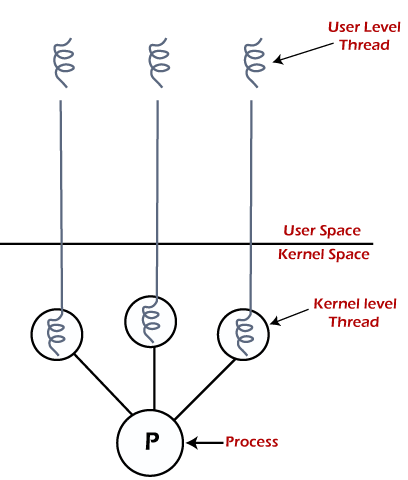Threads in Operating System (OS)
A thread is a single sequential flow of execution of tasks of a process so it is also known as thread of execution or thread of control. There is a way of thread execution inside the process of any operating system. Apart from this, there can be more than one thread inside a process. Each thread of the same process makes use of a separate program counter and a stack of activation records and control blocks. Thread is often referred to as a lightweight process.

The process can be split down into so many threads. For example, in a browser, many tabs can be viewed as threads. MS Word uses many threads - formatting text from one thread, processing input from another thread, etc.
Need of Thread:
- It takes far less time to create a new thread in an existing process than to create a new process.
- Threads can share the common data, they do not need to use Inter- Process communication.
- Context switching is faster when working with threads.
- It takes less time to terminate a thread than a process.
Types of Threads
In the operating system, there are two types of threads.
- Kernel level thread.
- User-level thread.
User-level thread
The operating system does not recognize the user-level thread. User threads can be easily implemented and it is implemented by the user. If a user performs a user-level thread blocking operation, the whole process is blocked. The kernel level thread does not know nothing about the user level thread. The kernel-level thread manages user-level threads as if they are single-threaded processes?examples: Java thread, POSIX threads, etc.
Advantages of User-level threads
- The user threads can be easily implemented than the kernel thread.
- User-level threads can be applied to such types of operating systems that do not support threads at the kernel-level.
- It is faster and efficient.
- Context switch time is shorter than the kernel-level threads.
- It does not require modifications of the operating system.
- User-level threads representation is very simple. The register, PC, stack, and mini thread control blocks are stored in the address space of the user-level process.
- It is simple to create, switch, and synchronize threads without the intervention of the process.
Disadvantages of User-level threads
- User-level threads lack coordination between the thread and the kernel.
- If a thread causes a page fault, the entire process is blocked.

Kernel level thread
The kernel thread recognizes the operating system. There is a thread control block and process control block in the system for each thread and process in the kernel-level thread. The kernel-level thread is implemented by the operating system. The kernel knows about all the threads and manages them. The kernel-level thread offers a system call to create and manage the threads from user-space. The implementation of kernel threads is more difficult than the user thread. Context switch time is longer in the kernel thread. If a kernel thread performs a blocking operation, the Banky thread execution can continue. Example: Window Solaris.

Advantages of Kernel-level threads
- The kernel-level thread is fully aware of all threads.
- The scheduler may decide to spend more CPU time in the process of threads being large numerical.
- The kernel-level thread is good for those applications that block the frequency.
Disadvantages of Kernel-level threads
- The kernel thread manages and schedules all threads.
- The implementation of kernel threads is difficult than the user thread.
- The kernel-level thread is slower than user-level threads.
Components of Threads
Any thread has the following components.
- Program counter
- Register set
- Stack space
Benefits of Threads
- Enhanced throughput of the system: When the process is split into many threads, and each thread is treated as a job, the number of jobs done in the unit time increases. That is why the throughput of the system also increases.
- Effective Utilization of Multiprocessor system: When you have more than one thread in one process, you can schedule more than one thread in more than one processor.
- Faster context switch: The context switching period between threads is less than the process context switching. The process context switch means more overhead for the CPU.
- Responsiveness: When the process is split into several threads, and when a thread completes its execution, that process can be responded to as soon as possible.
- Communication: Multiple-thread communication is simple because the threads share the same address space, while in process, we adopt just a few exclusive communication strategies for communication between two processes.
- Resource sharing: Resources can be shared between all threads within a process, such as code, data, and files. Note: The stack and register cannot be shared between threads. There is a stack and register for each thread.
|



 For Videos Join Our Youtube Channel: Join Now
For Videos Join Our Youtube Channel: Join Now










